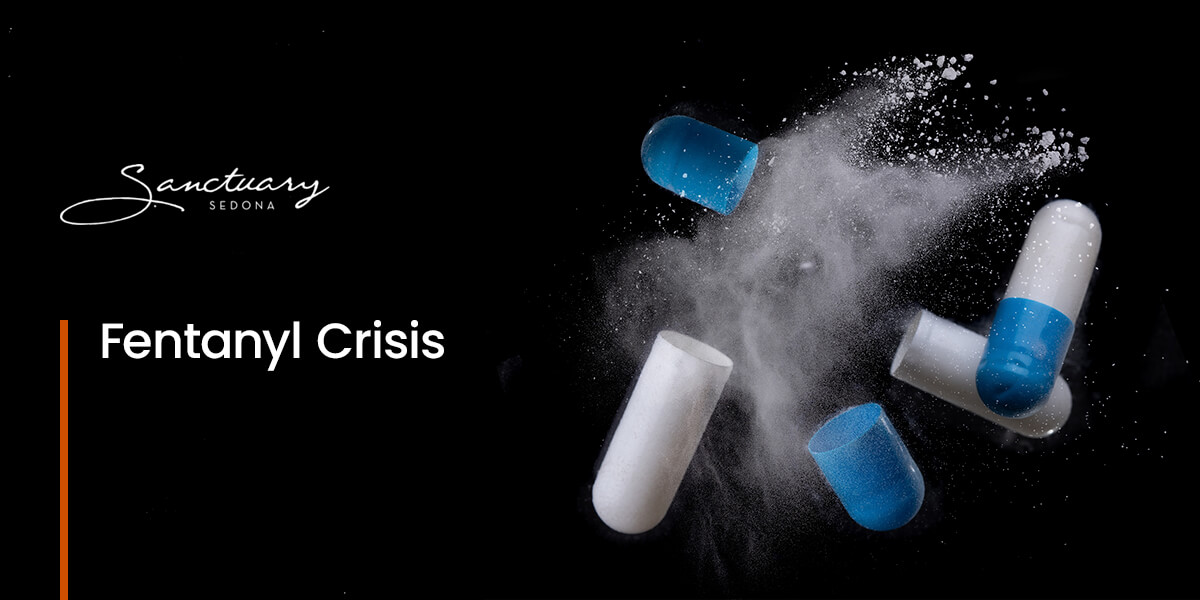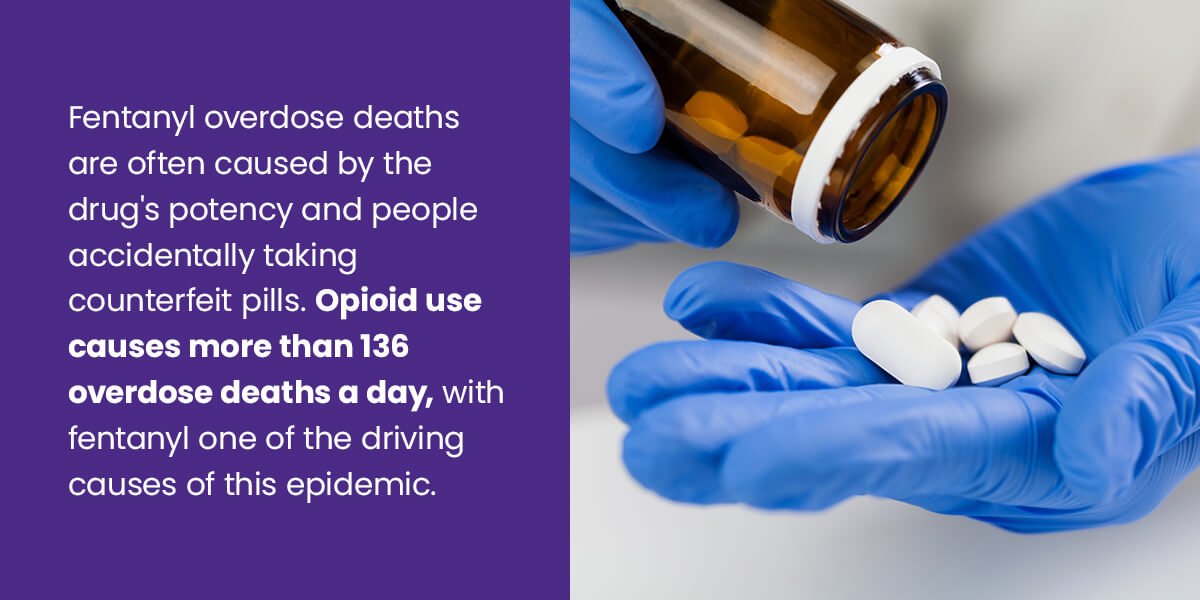Fentanyl is a powerful synthetic opioid responsible for more than 91,000 overdose deaths in 2020. Both illicit substances and prescription opioids contribute to the increasing fentanyl crisis in the United States. Illicitly manufactured fentanyl is often added to substances like counterfeit pills, heroin, methamphetamine, and cocaine. As a result, many people don’t realize when they’ve ingested fentanyl, leading to accidental overdose.
Even the tiniest dose of fentanyl exposure can cause life-threatening symptoms. That’s why it’s essential to learn more about fentanyl, its dangers, and how to get help if you struggle with substance use disorder.
What Is Fentanyl?
Fentanyl is a synthetic opioid 50 to 100 times more potent than morphine. It is a prescription drug that is also made and used illicitly. Often used to treat severe pain after surgery, fentanyl can also be prescribed to alleviate chronic pain in those tolerant to other opioids.
The substance can lead to tolerance, causing people to take more of the drug to get the desired effects. For this reason, fentanyl should only be taken as prescribed, as it can quickly lead to addiction. Substance use disorder can lead to significant health issues. Synthetic opioids like fentanyl are now the most common cause of the current overdose crisis in the U.S.
In its prescription form, fentanyl is better known by names like Sublimaze®, Actiq®, and Duragesic®. When prescribed by a health care professional, patients might receive fentanyl as a shot, patch on the skin or lozenge. Synthetic fentanyl that is sold illegally tends to be sold as a powder or made into pills that resemble other prescription opioids.
Many drug dealers mix fentanyl with other drugs like heroin and MDMA as it offers a cheaper way to produce a stronger high. It becomes especially risky when people taking drugs don’t realize they contain fentanyl. The potent opioid can be extremely dangerous to the body, especially those whose bodies are not used to them, making the person more likely to overdose.
How Does Fentanyl Affect the Body?
Fentanyl affects the body by producing temporary euphoria and can quickly cause slowed respiration, fainting, reduced blood pressure, and even seizures or death. Opioids work by depressing our central nervous system, causing functions like heart rate and breathing to become slower in the short term.
Physical symptoms of fentanyl use include:
- Relaxation or euphoria
- Pain relief
- Confusion
- Sedation
- Dizziness
- Drowsiness
- Nausea and vomiting
- Pupillary constriction
- Urinary retention
- Respiratory depression
Fentanyl use can lead to substance use disorder, which can have lasting implications on a person’s physical, social and emotional health. It’s important to know that anyone can develop fentanyl addiction, whether prescribed by a doctor or used illicitly. With prolonged use, individuals can experience withdrawal symptoms when attempting to stop.
Opioid withdrawal symptoms can include:
- Restlessness
- Insomnia
- Cold flashes
- Muscle and bone pain
- Goosebumps
- Diarrhea
- Vomiting
And, of course, fentanyl use leads to a high possibility of overdose, especially if used illicitly.
Overdose may result in the following symptoms:
- Small, constricted pupils
- Pale skin
- Unresponsive or inability to wake up
- Purple or blue fingernails or lips
- Clammy feet or hands
- Skin that feels cold to the touch
- Limpness
- Slow or irregular heartbeat
- Shallow or restricted breathing
- Anxiety or irritability
- Confusion
- Extreme sleepiness or inability to wake up
- Chest pain
It’s essential to seek emergency health care services immediately if you or someone you know experiences these overdose symptoms. An overdose can be fatal if left untreated.
The Fentanyl Crisis — Counterfeit Pills
Fentanyl overdose deaths are often caused by the drug’s potency and people accidentally taking counterfeit pills. Opioid use causes more than 136 overdose deaths a day, with fentanyl one of the driving causes of this epidemic. Overdose can occur at any stage of opioid addiction, whether accidentally or from chronic misuse of prescription opioids.
Research shows death rates from fentanyl poisoning are quickly growing among 14 to 18-year-olds, with fatal overdoses increasing by 20% at the beginning of 2021. Since drug use among teens is currently low, this points to how dangerous these substances have become.
While fentanyl was once mostly packaged as a powder and sold as counterfeit heroin, today, it’s pressed into pills that look like prescription drugs. So many teens think they’re taking Percocet, Xanax, or Vicodin and accidentally consume fentanyl instead. And these counterfeit pills are becoming increasingly lethal. In fact, the Drug Enforcement Administration (DEA) finds that six out of ten pills with fentanyl now contain a potentially lethal dose.
As a result, drug overdoses and death rates caused by this dangerous opiate continue to rise. Fake pills are highly accessible and often sold through social media and e-commerce platforms, making them available to everyone — even teens. Their wide availability puts this demographic at an increased risk. Parents must understand the dangers posed by the fentanyl crisis and how just one counterfeit pill can take a life.
What You Need to Know
When laced with other drugs, young people are at a high risk of accidentally ingesting fentanyl and experiencing an overdose. That’s why the only safe medications are those prescribed by a medical professional and dispensed by a licensed pharmacist.
The drug landscape has changed drastically over the years, making it essential for parents to understand current drug threats and have informed talks with their kids to mitigate risks.
When bringing this up with your child, the DEA promotes the following tips:
- Encourage open and honest communication.
- Explain what fentanyl is and its dangers.
- Inform them that no pill purchased on social media is safe.
- Stress that they should not take any pills that a doctor did not prescribe for them.
- Ensure they know fentanyl has been found in most illegal drugs.
- Discuss a plan to help your child escape if pressured to take a pill or use substances.
Doing our best to spread the word about the fentanyl overdose crisis can help educate more people and prevent overdose deaths. You might also connect with local resources to help yourself and your community.
It also helps to know that if you or someone you know is struggling with fentanyl addiction, you are not alone. Addiction treatment centers can diagnose addiction and get you started down a healthy, substance-free path.
How The Sanctuary’s Fentanyl Treatment Center Can Help
The fentanyl crisis has led to thousands of overdose deaths. While a complex issue, there are several ways you can help yourself or someone you know who may be impacted by addiction. By educating ourselves and utilizing drug treatment resources, we can begin to reduce the impact of this crisis.
At Sanctuary at Sedona, we provide a science-based recovery program to help you or a loved one recover from substance use disorder. Our integrative, holistic approach considers your entire situation, helping you through withdrawal and the underlying causes of your addiction. This way, you can receive more comprehensive treatment to help overcome fentanyl addiction once and for all.
At The Sanctuary, you’ll enter a warm, intimate space and receive treatment from an expert, licensed practitioners of medicine and behavioral therapy. Our services include dual diagnosis treatment, trauma-focused and clinical care, ongoing treatment, and luxury accommodations to help you recover.
To learn more about our treatment process, contact us today.



